NZDB6213: Financial Management Plan Report for Auckland Airport
VerifiedAdded on 2022/09/09
|19
|2730
|18
Report
AI Summary
This report presents a comprehensive financial management plan for Auckland International Airport, examining its financial performance, stakeholders, and risk management strategies. The report analyzes the airport's operations, profitability, and solvency ratios over three financial years, highlighting trends and interpretations. It delves into capital budgeting techniques, including NPV and IRR, to assess investment viability. The analysis also covers risk and return, country risks, internal and external compliance, and ethical considerations. The report identifies key stakeholders and their interests, along with the company's compliance with relevant regulations. Furthermore, it discusses the company's operational, accounting, sales, and marketing practices. The report concludes with an overview of the ethical and cultural aspects influencing financial decision-making within the organization.
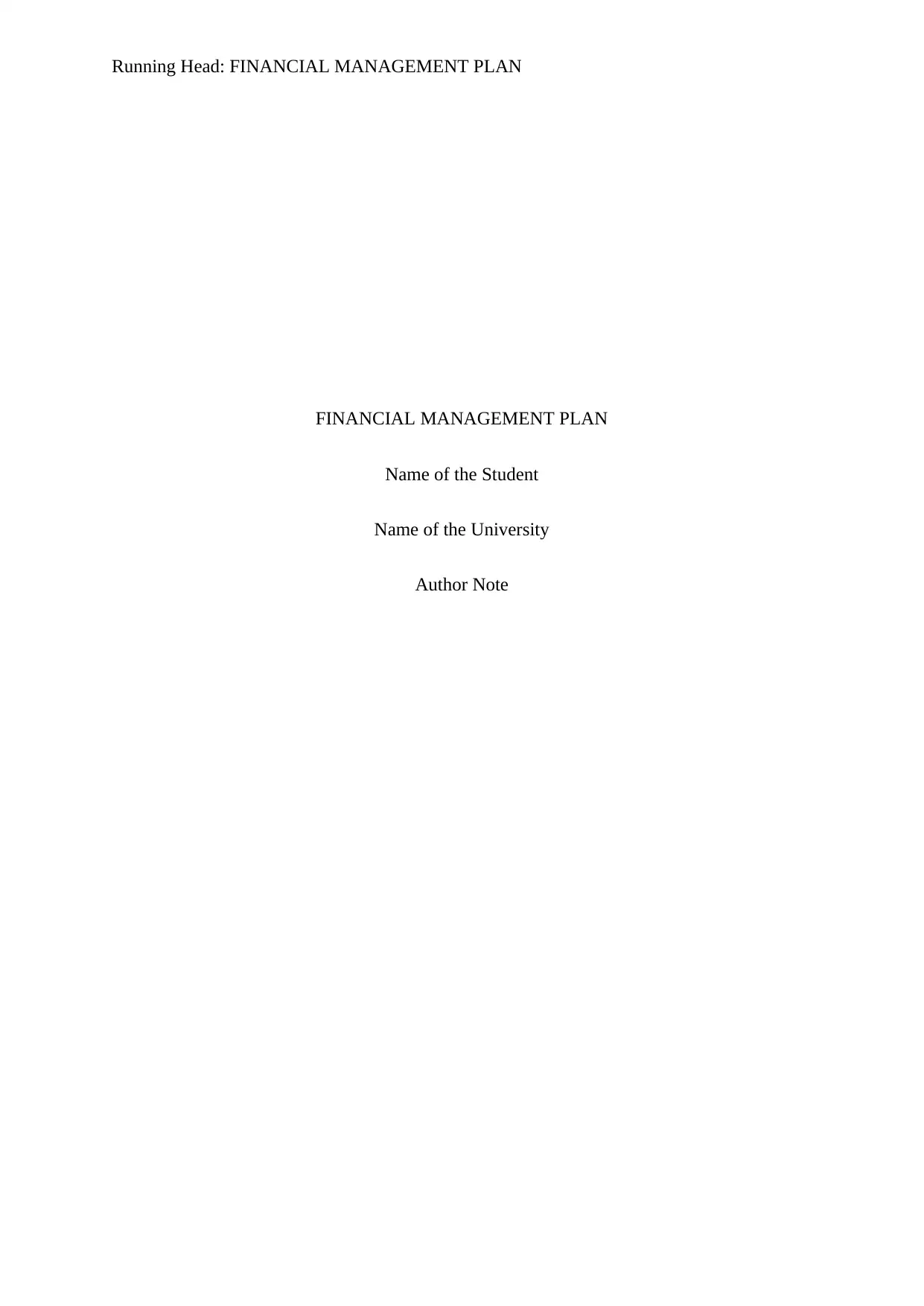
Running Head: FINANCIAL MANAGEMENT PLAN
FINANCIAL MANAGEMENT PLAN
Name of the Student
Name of the University
Author Note
FINANCIAL MANAGEMENT PLAN
Name of the Student
Name of the University
Author Note
Paraphrase This Document
Need a fresh take? Get an instant paraphrase of this document with our AI Paraphraser
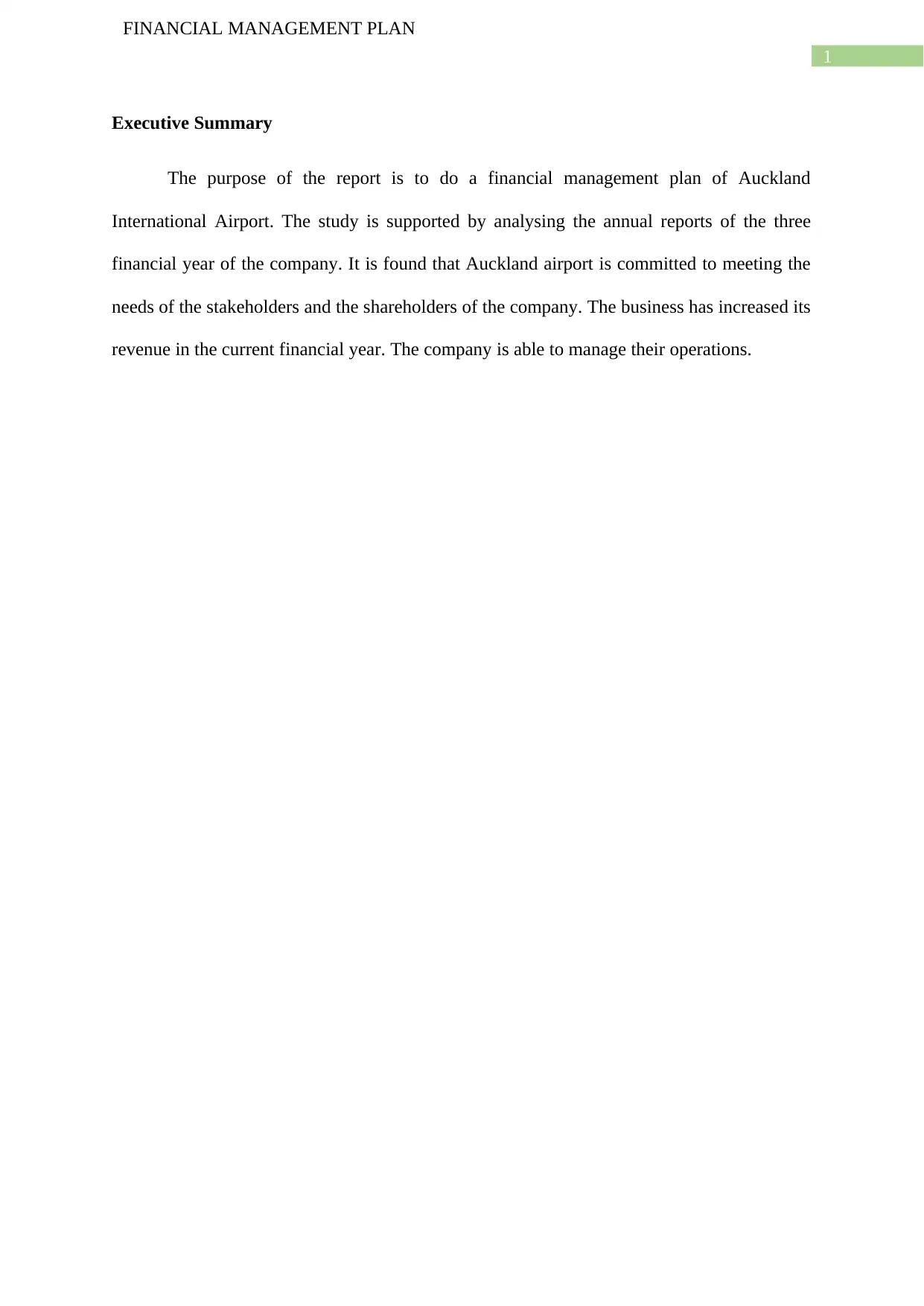
1
FINANCIAL MANAGEMENT PLAN
Executive Summary
The purpose of the report is to do a financial management plan of Auckland
International Airport. The study is supported by analysing the annual reports of the three
financial year of the company. It is found that Auckland airport is committed to meeting the
needs of the stakeholders and the shareholders of the company. The business has increased its
revenue in the current financial year. The company is able to manage their operations.
FINANCIAL MANAGEMENT PLAN
Executive Summary
The purpose of the report is to do a financial management plan of Auckland
International Airport. The study is supported by analysing the annual reports of the three
financial year of the company. It is found that Auckland airport is committed to meeting the
needs of the stakeholders and the shareholders of the company. The business has increased its
revenue in the current financial year. The company is able to manage their operations.
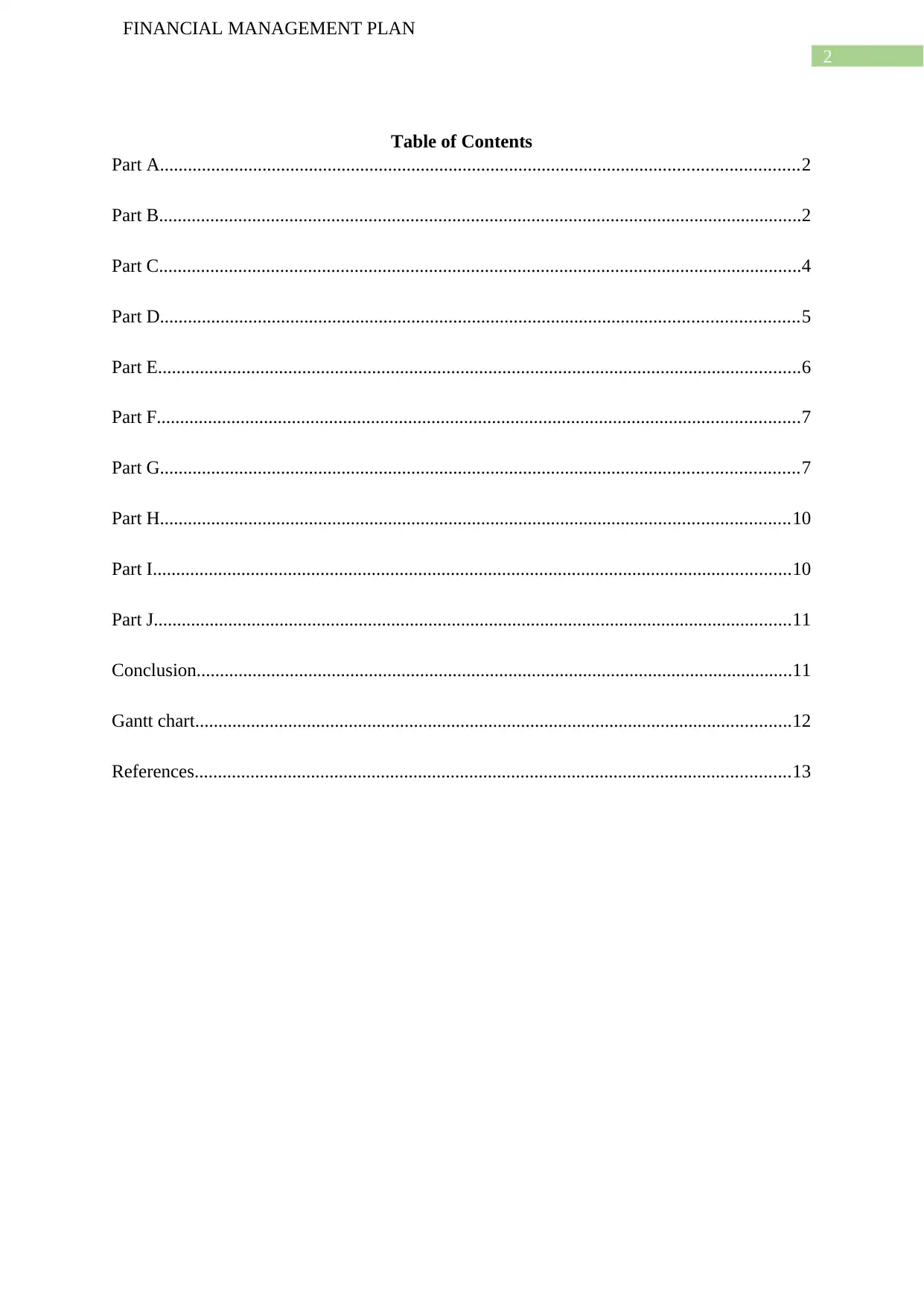
2
FINANCIAL MANAGEMENT PLAN
Table of Contents
Part A.........................................................................................................................................2
Part B..........................................................................................................................................2
Part C..........................................................................................................................................4
Part D.........................................................................................................................................5
Part E..........................................................................................................................................6
Part F..........................................................................................................................................7
Part G.........................................................................................................................................7
Part H.......................................................................................................................................10
Part I.........................................................................................................................................10
Part J.........................................................................................................................................11
Conclusion................................................................................................................................11
Gantt chart................................................................................................................................12
References................................................................................................................................13
FINANCIAL MANAGEMENT PLAN
Table of Contents
Part A.........................................................................................................................................2
Part B..........................................................................................................................................2
Part C..........................................................................................................................................4
Part D.........................................................................................................................................5
Part E..........................................................................................................................................6
Part F..........................................................................................................................................7
Part G.........................................................................................................................................7
Part H.......................................................................................................................................10
Part I.........................................................................................................................................10
Part J.........................................................................................................................................11
Conclusion................................................................................................................................11
Gantt chart................................................................................................................................12
References................................................................................................................................13
⊘ This is a preview!⊘
Do you want full access?
Subscribe today to unlock all pages.

Trusted by 1+ million students worldwide
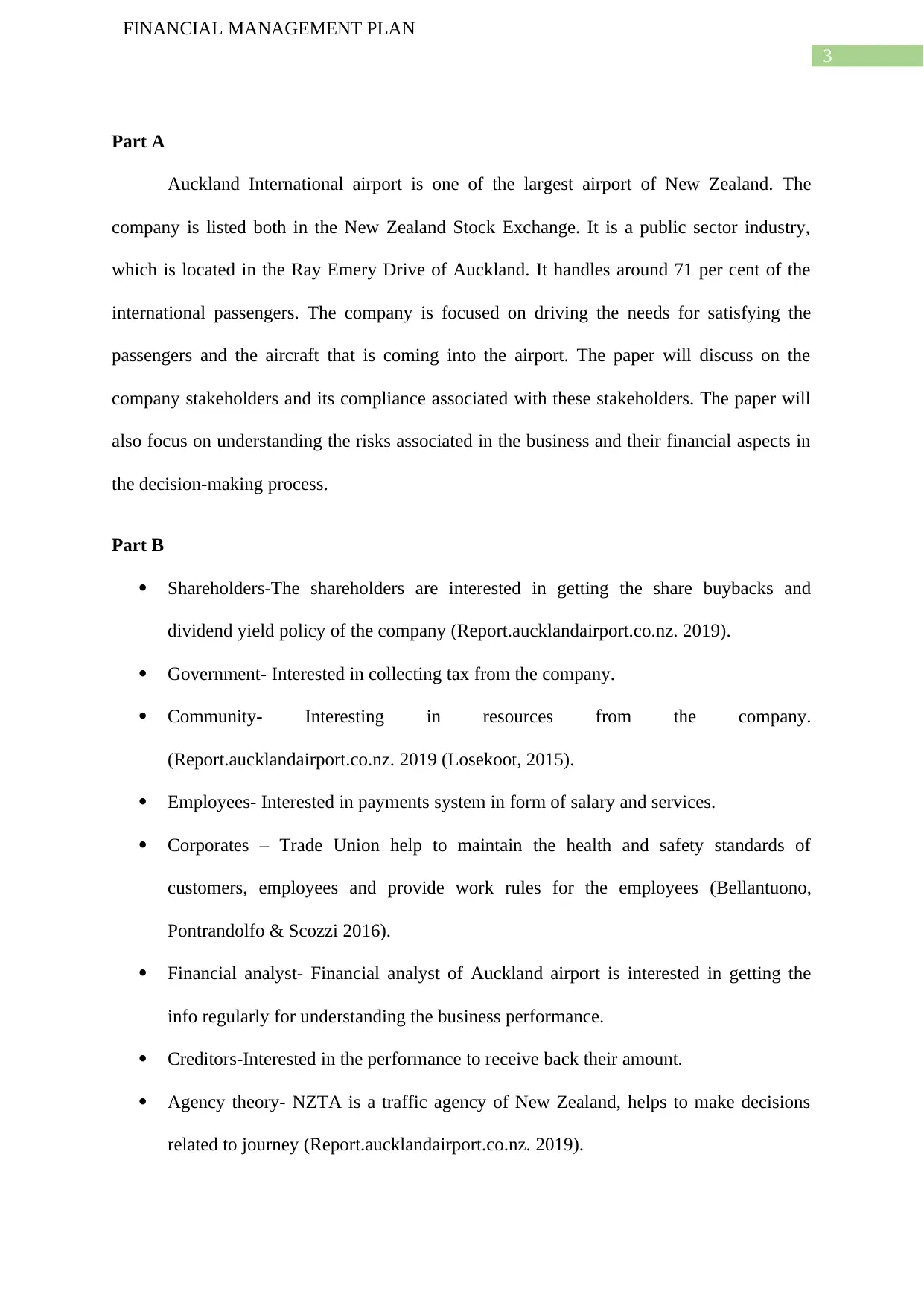
3
FINANCIAL MANAGEMENT PLAN
Part A
Auckland International airport is one of the largest airport of New Zealand. The
company is listed both in the New Zealand Stock Exchange. It is a public sector industry,
which is located in the Ray Emery Drive of Auckland. It handles around 71 per cent of the
international passengers. The company is focused on driving the needs for satisfying the
passengers and the aircraft that is coming into the airport. The paper will discuss on the
company stakeholders and its compliance associated with these stakeholders. The paper will
also focus on understanding the risks associated in the business and their financial aspects in
the decision-making process.
Part B
Shareholders-The shareholders are interested in getting the share buybacks and
dividend yield policy of the company (Report.aucklandairport.co.nz. 2019).
Government- Interested in collecting tax from the company.
Community- Interesting in resources from the company.
(Report.aucklandairport.co.nz. 2019 (Losekoot, 2015).
Employees- Interested in payments system in form of salary and services.
Corporates – Trade Union help to maintain the health and safety standards of
customers, employees and provide work rules for the employees (Bellantuono,
Pontrandolfo & Scozzi 2016).
Financial analyst- Financial analyst of Auckland airport is interested in getting the
info regularly for understanding the business performance.
Creditors-Interested in the performance to receive back their amount.
Agency theory- NZTA is a traffic agency of New Zealand, helps to make decisions
related to journey (Report.aucklandairport.co.nz. 2019).
FINANCIAL MANAGEMENT PLAN
Part A
Auckland International airport is one of the largest airport of New Zealand. The
company is listed both in the New Zealand Stock Exchange. It is a public sector industry,
which is located in the Ray Emery Drive of Auckland. It handles around 71 per cent of the
international passengers. The company is focused on driving the needs for satisfying the
passengers and the aircraft that is coming into the airport. The paper will discuss on the
company stakeholders and its compliance associated with these stakeholders. The paper will
also focus on understanding the risks associated in the business and their financial aspects in
the decision-making process.
Part B
Shareholders-The shareholders are interested in getting the share buybacks and
dividend yield policy of the company (Report.aucklandairport.co.nz. 2019).
Government- Interested in collecting tax from the company.
Community- Interesting in resources from the company.
(Report.aucklandairport.co.nz. 2019 (Losekoot, 2015).
Employees- Interested in payments system in form of salary and services.
Corporates – Trade Union help to maintain the health and safety standards of
customers, employees and provide work rules for the employees (Bellantuono,
Pontrandolfo & Scozzi 2016).
Financial analyst- Financial analyst of Auckland airport is interested in getting the
info regularly for understanding the business performance.
Creditors-Interested in the performance to receive back their amount.
Agency theory- NZTA is a traffic agency of New Zealand, helps to make decisions
related to journey (Report.aucklandairport.co.nz. 2019).
Paraphrase This Document
Need a fresh take? Get an instant paraphrase of this document with our AI Paraphraser
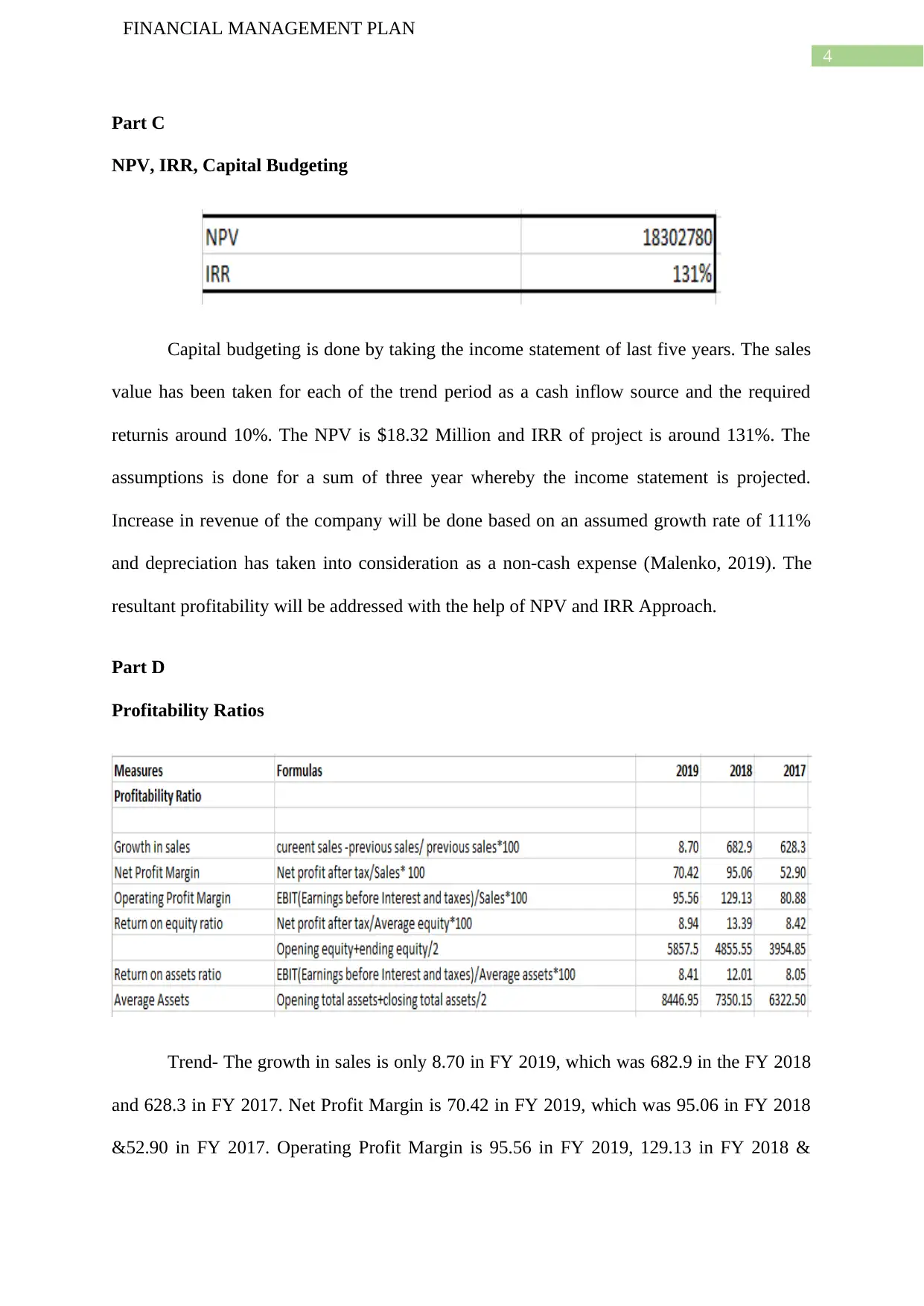
4
FINANCIAL MANAGEMENT PLAN
Part C
NPV, IRR, Capital Budgeting
Capital budgeting is done by taking the income statement of last five years. The sales
value has been taken for each of the trend period as a cash inflow source and the required
returnis around 10%. The NPV is $18.32 Million and IRR of project is around 131%. The
assumptions is done for a sum of three year whereby the income statement is projected.
Increase in revenue of the company will be done based on an assumed growth rate of 111%
and depreciation has taken into consideration as a non-cash expense (Malenko, 2019). The
resultant profitability will be addressed with the help of NPV and IRR Approach.
Part D
Profitability Ratios
Trend- The growth in sales is only 8.70 in FY 2019, which was 682.9 in the FY 2018
and 628.3 in FY 2017. Net Profit Margin is 70.42 in FY 2019, which was 95.06 in FY 2018
&52.90 in FY 2017. Operating Profit Margin is 95.56 in FY 2019, 129.13 in FY 2018 &
FINANCIAL MANAGEMENT PLAN
Part C
NPV, IRR, Capital Budgeting
Capital budgeting is done by taking the income statement of last five years. The sales
value has been taken for each of the trend period as a cash inflow source and the required
returnis around 10%. The NPV is $18.32 Million and IRR of project is around 131%. The
assumptions is done for a sum of three year whereby the income statement is projected.
Increase in revenue of the company will be done based on an assumed growth rate of 111%
and depreciation has taken into consideration as a non-cash expense (Malenko, 2019). The
resultant profitability will be addressed with the help of NPV and IRR Approach.
Part D
Profitability Ratios
Trend- The growth in sales is only 8.70 in FY 2019, which was 682.9 in the FY 2018
and 628.3 in FY 2017. Net Profit Margin is 70.42 in FY 2019, which was 95.06 in FY 2018
&52.90 in FY 2017. Operating Profit Margin is 95.56 in FY 2019, 129.13 in FY 2018 &
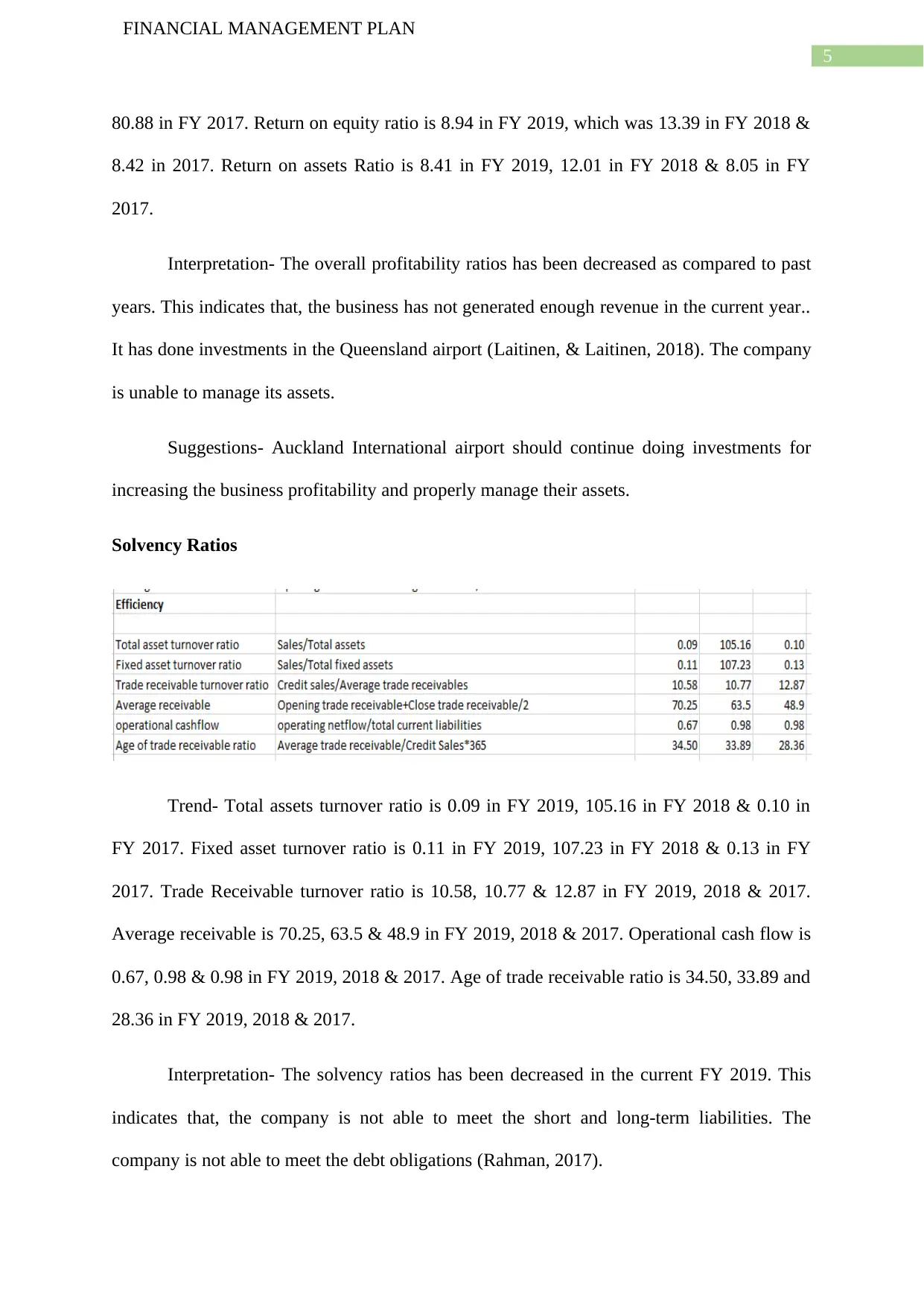
5
FINANCIAL MANAGEMENT PLAN
80.88 in FY 2017. Return on equity ratio is 8.94 in FY 2019, which was 13.39 in FY 2018 &
8.42 in 2017. Return on assets Ratio is 8.41 in FY 2019, 12.01 in FY 2018 & 8.05 in FY
2017.
Interpretation- The overall profitability ratios has been decreased as compared to past
years. This indicates that, the business has not generated enough revenue in the current year..
It has done investments in the Queensland airport (Laitinen, & Laitinen, 2018). The company
is unable to manage its assets.
Suggestions- Auckland International airport should continue doing investments for
increasing the business profitability and properly manage their assets.
Solvency Ratios
Trend- Total assets turnover ratio is 0.09 in FY 2019, 105.16 in FY 2018 & 0.10 in
FY 2017. Fixed asset turnover ratio is 0.11 in FY 2019, 107.23 in FY 2018 & 0.13 in FY
2017. Trade Receivable turnover ratio is 10.58, 10.77 & 12.87 in FY 2019, 2018 & 2017.
Average receivable is 70.25, 63.5 & 48.9 in FY 2019, 2018 & 2017. Operational cash flow is
0.67, 0.98 & 0.98 in FY 2019, 2018 & 2017. Age of trade receivable ratio is 34.50, 33.89 and
28.36 in FY 2019, 2018 & 2017.
Interpretation- The solvency ratios has been decreased in the current FY 2019. This
indicates that, the company is not able to meet the short and long-term liabilities. The
company is not able to meet the debt obligations (Rahman, 2017).
FINANCIAL MANAGEMENT PLAN
80.88 in FY 2017. Return on equity ratio is 8.94 in FY 2019, which was 13.39 in FY 2018 &
8.42 in 2017. Return on assets Ratio is 8.41 in FY 2019, 12.01 in FY 2018 & 8.05 in FY
2017.
Interpretation- The overall profitability ratios has been decreased as compared to past
years. This indicates that, the business has not generated enough revenue in the current year..
It has done investments in the Queensland airport (Laitinen, & Laitinen, 2018). The company
is unable to manage its assets.
Suggestions- Auckland International airport should continue doing investments for
increasing the business profitability and properly manage their assets.
Solvency Ratios
Trend- Total assets turnover ratio is 0.09 in FY 2019, 105.16 in FY 2018 & 0.10 in
FY 2017. Fixed asset turnover ratio is 0.11 in FY 2019, 107.23 in FY 2018 & 0.13 in FY
2017. Trade Receivable turnover ratio is 10.58, 10.77 & 12.87 in FY 2019, 2018 & 2017.
Average receivable is 70.25, 63.5 & 48.9 in FY 2019, 2018 & 2017. Operational cash flow is
0.67, 0.98 & 0.98 in FY 2019, 2018 & 2017. Age of trade receivable ratio is 34.50, 33.89 and
28.36 in FY 2019, 2018 & 2017.
Interpretation- The solvency ratios has been decreased in the current FY 2019. This
indicates that, the company is not able to meet the short and long-term liabilities. The
company is not able to meet the debt obligations (Rahman, 2017).
⊘ This is a preview!⊘
Do you want full access?
Subscribe today to unlock all pages.

Trusted by 1+ million students worldwide
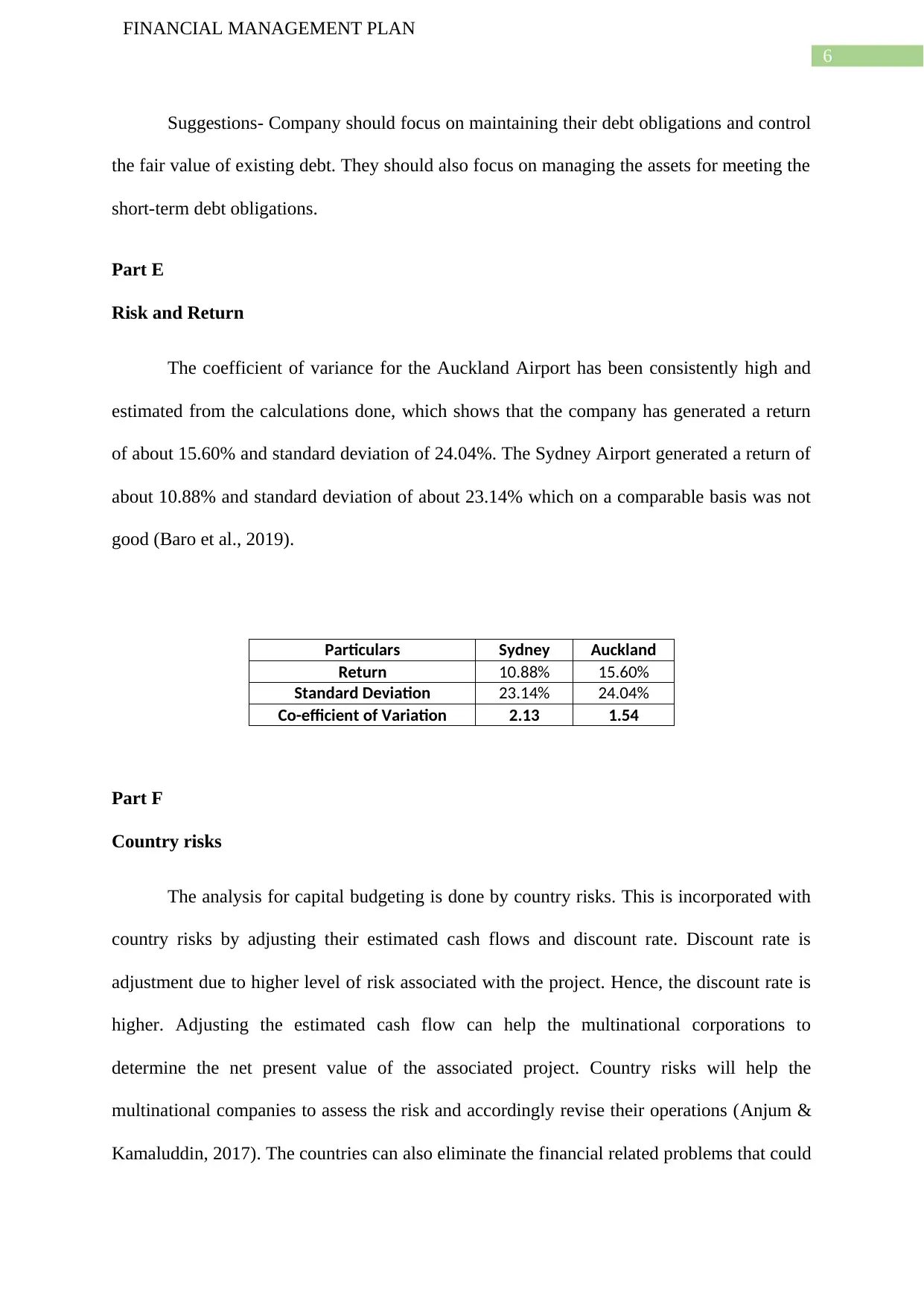
6
FINANCIAL MANAGEMENT PLAN
Suggestions- Company should focus on maintaining their debt obligations and control
the fair value of existing debt. They should also focus on managing the assets for meeting the
short-term debt obligations.
Part E
Risk and Return
The coefficient of variance for the Auckland Airport has been consistently high and
estimated from the calculations done, which shows that the company has generated a return
of about 15.60% and standard deviation of 24.04%. The Sydney Airport generated a return of
about 10.88% and standard deviation of about 23.14% which on a comparable basis was not
good (Baro et al., 2019).
Particulars Sydney Auckland
Return 10.88% 15.60%
Standard Deviation 23.14% 24.04%
Co-efficient of Variation 2.13 1.54
Part F
Country risks
The analysis for capital budgeting is done by country risks. This is incorporated with
country risks by adjusting their estimated cash flows and discount rate. Discount rate is
adjustment due to higher level of risk associated with the project. Hence, the discount rate is
higher. Adjusting the estimated cash flow can help the multinational corporations to
determine the net present value of the associated project. Country risks will help the
multinational companies to assess the risk and accordingly revise their operations (Anjum &
Kamaluddin, 2017). The countries can also eliminate the financial related problems that could
FINANCIAL MANAGEMENT PLAN
Suggestions- Company should focus on maintaining their debt obligations and control
the fair value of existing debt. They should also focus on managing the assets for meeting the
short-term debt obligations.
Part E
Risk and Return
The coefficient of variance for the Auckland Airport has been consistently high and
estimated from the calculations done, which shows that the company has generated a return
of about 15.60% and standard deviation of 24.04%. The Sydney Airport generated a return of
about 10.88% and standard deviation of about 23.14% which on a comparable basis was not
good (Baro et al., 2019).
Particulars Sydney Auckland
Return 10.88% 15.60%
Standard Deviation 23.14% 24.04%
Co-efficient of Variation 2.13 1.54
Part F
Country risks
The analysis for capital budgeting is done by country risks. This is incorporated with
country risks by adjusting their estimated cash flows and discount rate. Discount rate is
adjustment due to higher level of risk associated with the project. Hence, the discount rate is
higher. Adjusting the estimated cash flow can help the multinational corporations to
determine the net present value of the associated project. Country risks will help the
multinational companies to assess the risk and accordingly revise their operations (Anjum &
Kamaluddin, 2017). The countries can also eliminate the financial related problems that could
Paraphrase This Document
Need a fresh take? Get an instant paraphrase of this document with our AI Paraphraser
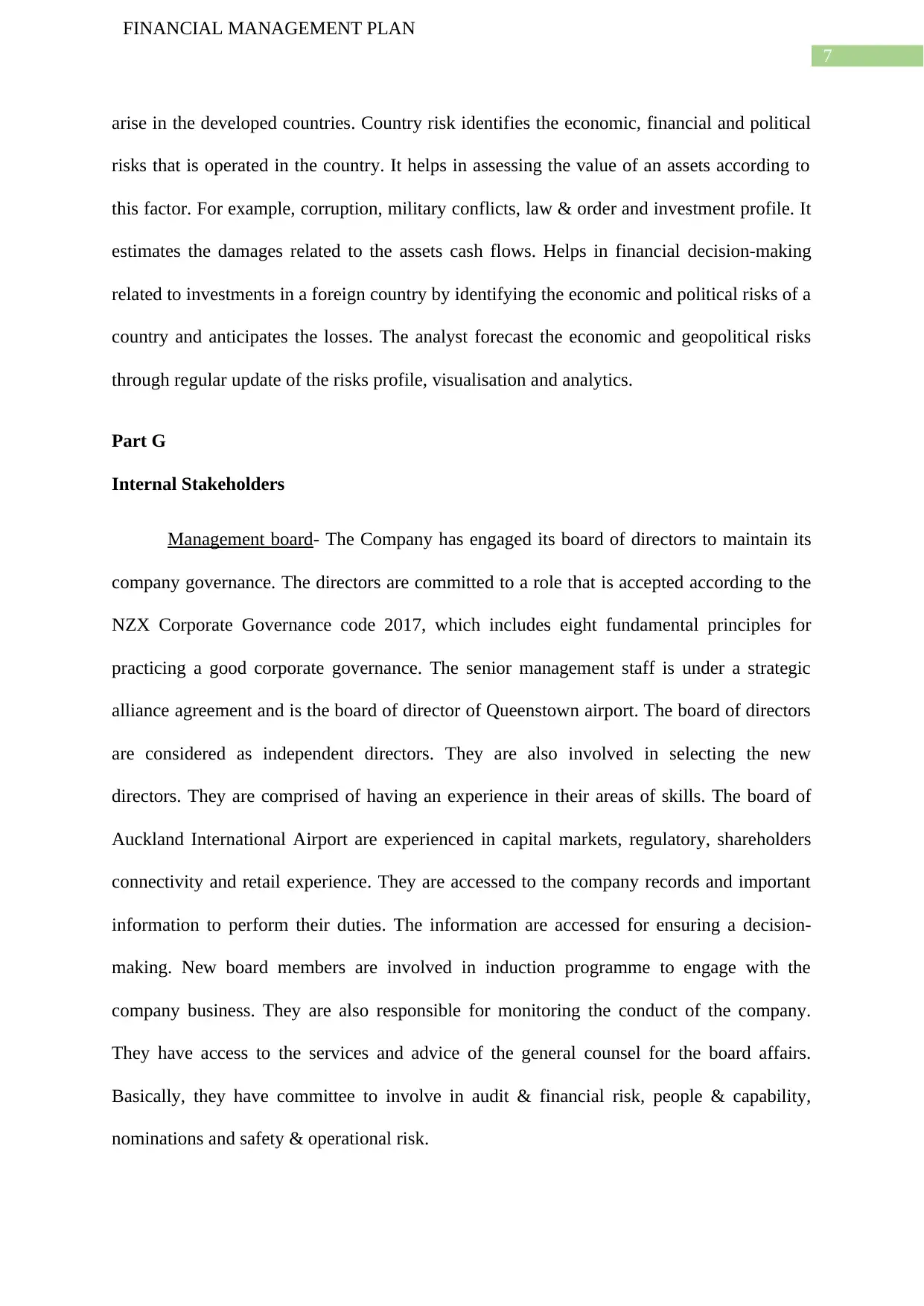
7
FINANCIAL MANAGEMENT PLAN
arise in the developed countries. Country risk identifies the economic, financial and political
risks that is operated in the country. It helps in assessing the value of an assets according to
this factor. For example, corruption, military conflicts, law & order and investment profile. It
estimates the damages related to the assets cash flows. Helps in financial decision-making
related to investments in a foreign country by identifying the economic and political risks of a
country and anticipates the losses. The analyst forecast the economic and geopolitical risks
through regular update of the risks profile, visualisation and analytics.
Part G
Internal Stakeholders
Management board- The Company has engaged its board of directors to maintain its
company governance. The directors are committed to a role that is accepted according to the
NZX Corporate Governance code 2017, which includes eight fundamental principles for
practicing a good corporate governance. The senior management staff is under a strategic
alliance agreement and is the board of director of Queenstown airport. The board of directors
are considered as independent directors. They are also involved in selecting the new
directors. They are comprised of having an experience in their areas of skills. The board of
Auckland International Airport are experienced in capital markets, regulatory, shareholders
connectivity and retail experience. They are accessed to the company records and important
information to perform their duties. The information are accessed for ensuring a decision-
making. New board members are involved in induction programme to engage with the
company business. They are also responsible for monitoring the conduct of the company.
They have access to the services and advice of the general counsel for the board affairs.
Basically, they have committee to involve in audit & financial risk, people & capability,
nominations and safety & operational risk.
FINANCIAL MANAGEMENT PLAN
arise in the developed countries. Country risk identifies the economic, financial and political
risks that is operated in the country. It helps in assessing the value of an assets according to
this factor. For example, corruption, military conflicts, law & order and investment profile. It
estimates the damages related to the assets cash flows. Helps in financial decision-making
related to investments in a foreign country by identifying the economic and political risks of a
country and anticipates the losses. The analyst forecast the economic and geopolitical risks
through regular update of the risks profile, visualisation and analytics.
Part G
Internal Stakeholders
Management board- The Company has engaged its board of directors to maintain its
company governance. The directors are committed to a role that is accepted according to the
NZX Corporate Governance code 2017, which includes eight fundamental principles for
practicing a good corporate governance. The senior management staff is under a strategic
alliance agreement and is the board of director of Queenstown airport. The board of directors
are considered as independent directors. They are also involved in selecting the new
directors. They are comprised of having an experience in their areas of skills. The board of
Auckland International Airport are experienced in capital markets, regulatory, shareholders
connectivity and retail experience. They are accessed to the company records and important
information to perform their duties. The information are accessed for ensuring a decision-
making. New board members are involved in induction programme to engage with the
company business. They are also responsible for monitoring the conduct of the company.
They have access to the services and advice of the general counsel for the board affairs.
Basically, they have committee to involve in audit & financial risk, people & capability,
nominations and safety & operational risk.
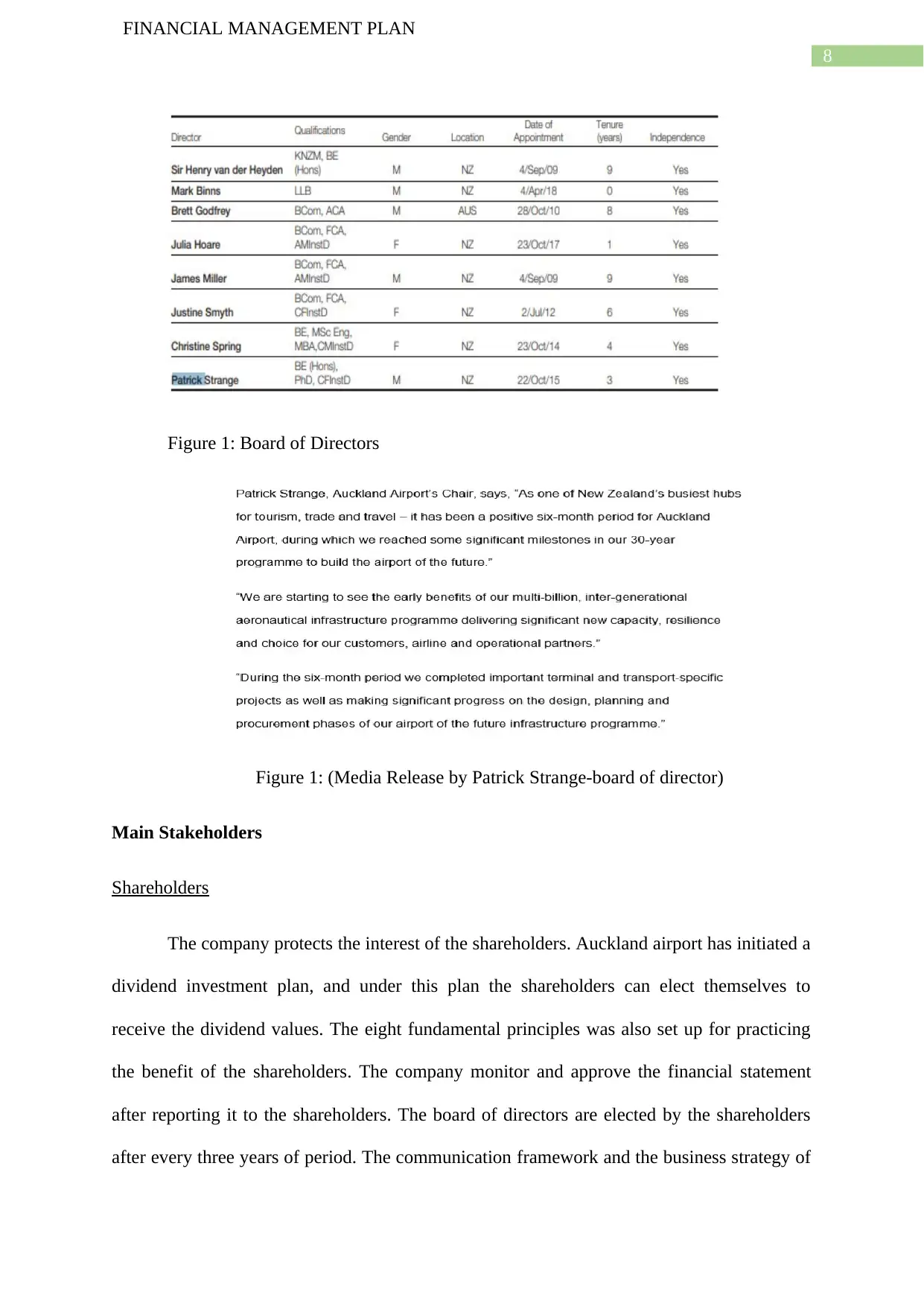
8
FINANCIAL MANAGEMENT PLAN
Figure 1: Board of Directors
Figure 1: (Media Release by Patrick Strange-board of director)
Main Stakeholders
Shareholders
The company protects the interest of the shareholders. Auckland airport has initiated a
dividend investment plan, and under this plan the shareholders can elect themselves to
receive the dividend values. The eight fundamental principles was also set up for practicing
the benefit of the shareholders. The company monitor and approve the financial statement
after reporting it to the shareholders. The board of directors are elected by the shareholders
after every three years of period. The communication framework and the business strategy of
FINANCIAL MANAGEMENT PLAN
Figure 1: Board of Directors
Figure 1: (Media Release by Patrick Strange-board of director)
Main Stakeholders
Shareholders
The company protects the interest of the shareholders. Auckland airport has initiated a
dividend investment plan, and under this plan the shareholders can elect themselves to
receive the dividend values. The eight fundamental principles was also set up for practicing
the benefit of the shareholders. The company monitor and approve the financial statement
after reporting it to the shareholders. The board of directors are elected by the shareholders
after every three years of period. The communication framework and the business strategy of
⊘ This is a preview!⊘
Do you want full access?
Subscribe today to unlock all pages.

Trusted by 1+ million students worldwide
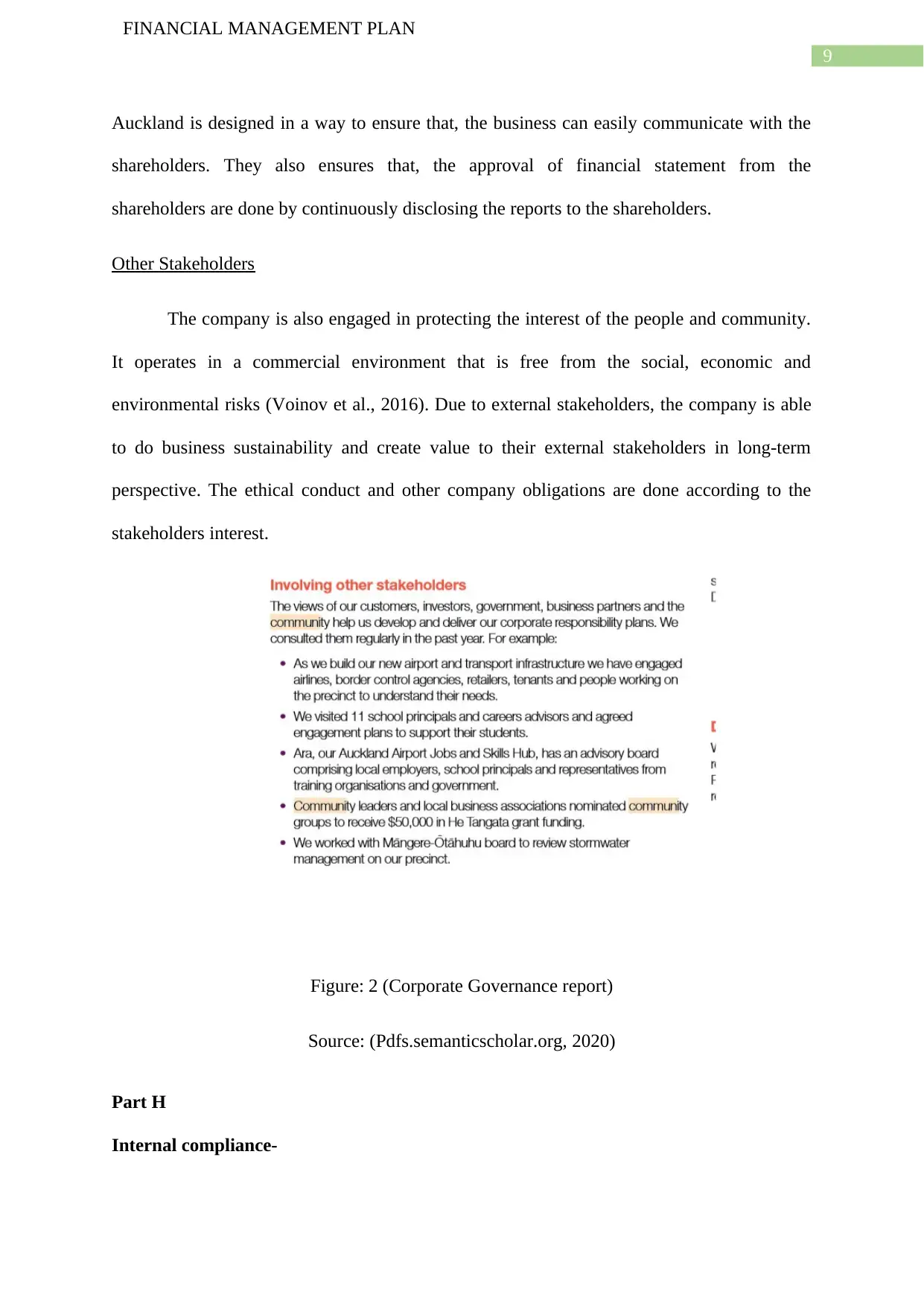
9
FINANCIAL MANAGEMENT PLAN
Auckland is designed in a way to ensure that, the business can easily communicate with the
shareholders. They also ensures that, the approval of financial statement from the
shareholders are done by continuously disclosing the reports to the shareholders.
Other Stakeholders
The company is also engaged in protecting the interest of the people and community.
It operates in a commercial environment that is free from the social, economic and
environmental risks (Voinov et al., 2016). Due to external stakeholders, the company is able
to do business sustainability and create value to their external stakeholders in long-term
perspective. The ethical conduct and other company obligations are done according to the
stakeholders interest.
Figure: 2 (Corporate Governance report)
Source: (Pdfs.semanticscholar.org, 2020)
Part H
Internal compliance-
FINANCIAL MANAGEMENT PLAN
Auckland is designed in a way to ensure that, the business can easily communicate with the
shareholders. They also ensures that, the approval of financial statement from the
shareholders are done by continuously disclosing the reports to the shareholders.
Other Stakeholders
The company is also engaged in protecting the interest of the people and community.
It operates in a commercial environment that is free from the social, economic and
environmental risks (Voinov et al., 2016). Due to external stakeholders, the company is able
to do business sustainability and create value to their external stakeholders in long-term
perspective. The ethical conduct and other company obligations are done according to the
stakeholders interest.
Figure: 2 (Corporate Governance report)
Source: (Pdfs.semanticscholar.org, 2020)
Part H
Internal compliance-
Paraphrase This Document
Need a fresh take? Get an instant paraphrase of this document with our AI Paraphraser
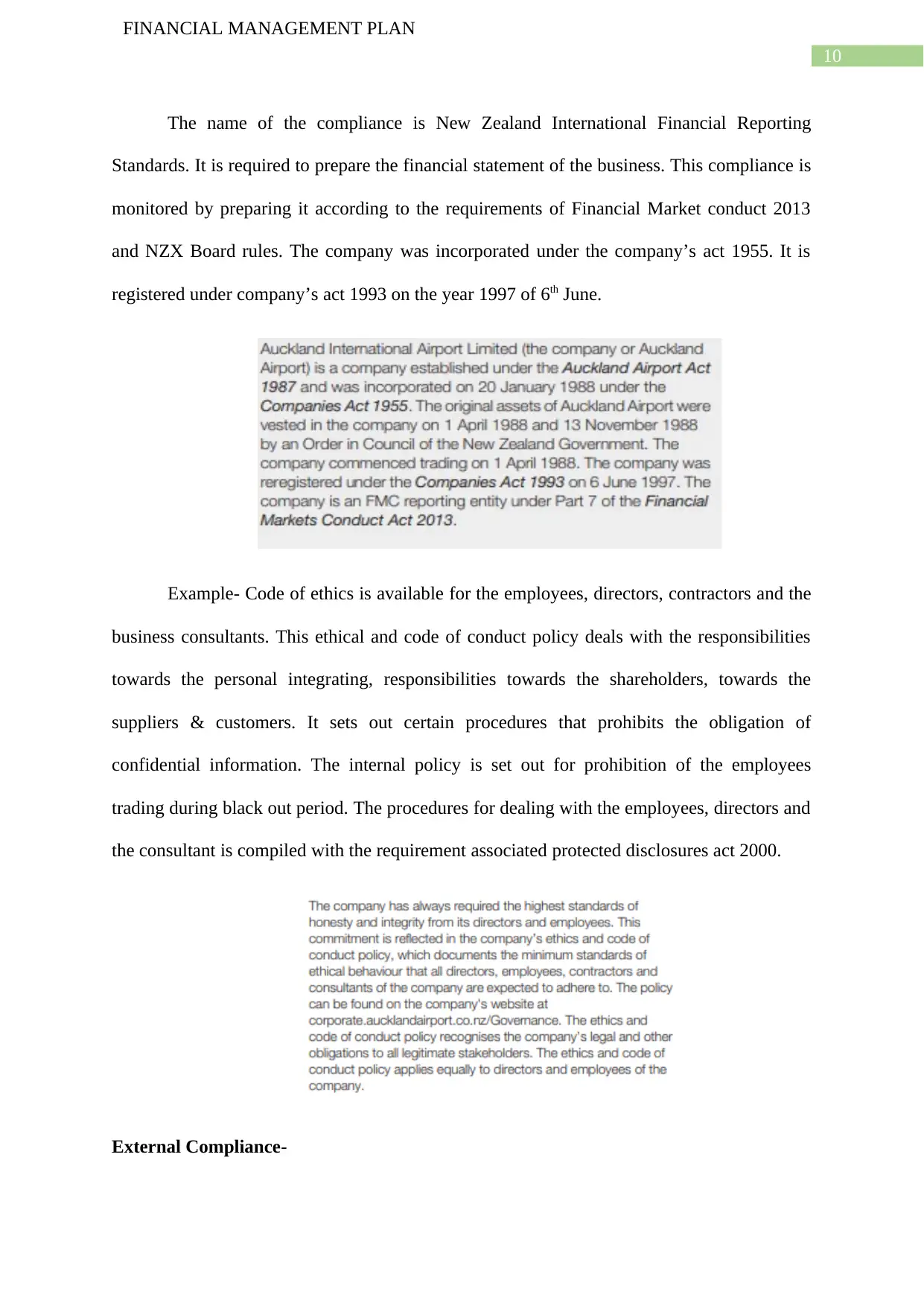
10
FINANCIAL MANAGEMENT PLAN
The name of the compliance is New Zealand International Financial Reporting
Standards. It is required to prepare the financial statement of the business. This compliance is
monitored by preparing it according to the requirements of Financial Market conduct 2013
and NZX Board rules. The company was incorporated under the company’s act 1955. It is
registered under company’s act 1993 on the year 1997 of 6th June.
Example- Code of ethics is available for the employees, directors, contractors and the
business consultants. This ethical and code of conduct policy deals with the responsibilities
towards the personal integrating, responsibilities towards the shareholders, towards the
suppliers & customers. It sets out certain procedures that prohibits the obligation of
confidential information. The internal policy is set out for prohibition of the employees
trading during black out period. The procedures for dealing with the employees, directors and
the consultant is compiled with the requirement associated protected disclosures act 2000.
External Compliance-
FINANCIAL MANAGEMENT PLAN
The name of the compliance is New Zealand International Financial Reporting
Standards. It is required to prepare the financial statement of the business. This compliance is
monitored by preparing it according to the requirements of Financial Market conduct 2013
and NZX Board rules. The company was incorporated under the company’s act 1955. It is
registered under company’s act 1993 on the year 1997 of 6th June.
Example- Code of ethics is available for the employees, directors, contractors and the
business consultants. This ethical and code of conduct policy deals with the responsibilities
towards the personal integrating, responsibilities towards the shareholders, towards the
suppliers & customers. It sets out certain procedures that prohibits the obligation of
confidential information. The internal policy is set out for prohibition of the employees
trading during black out period. The procedures for dealing with the employees, directors and
the consultant is compiled with the requirement associated protected disclosures act 2000.
External Compliance-
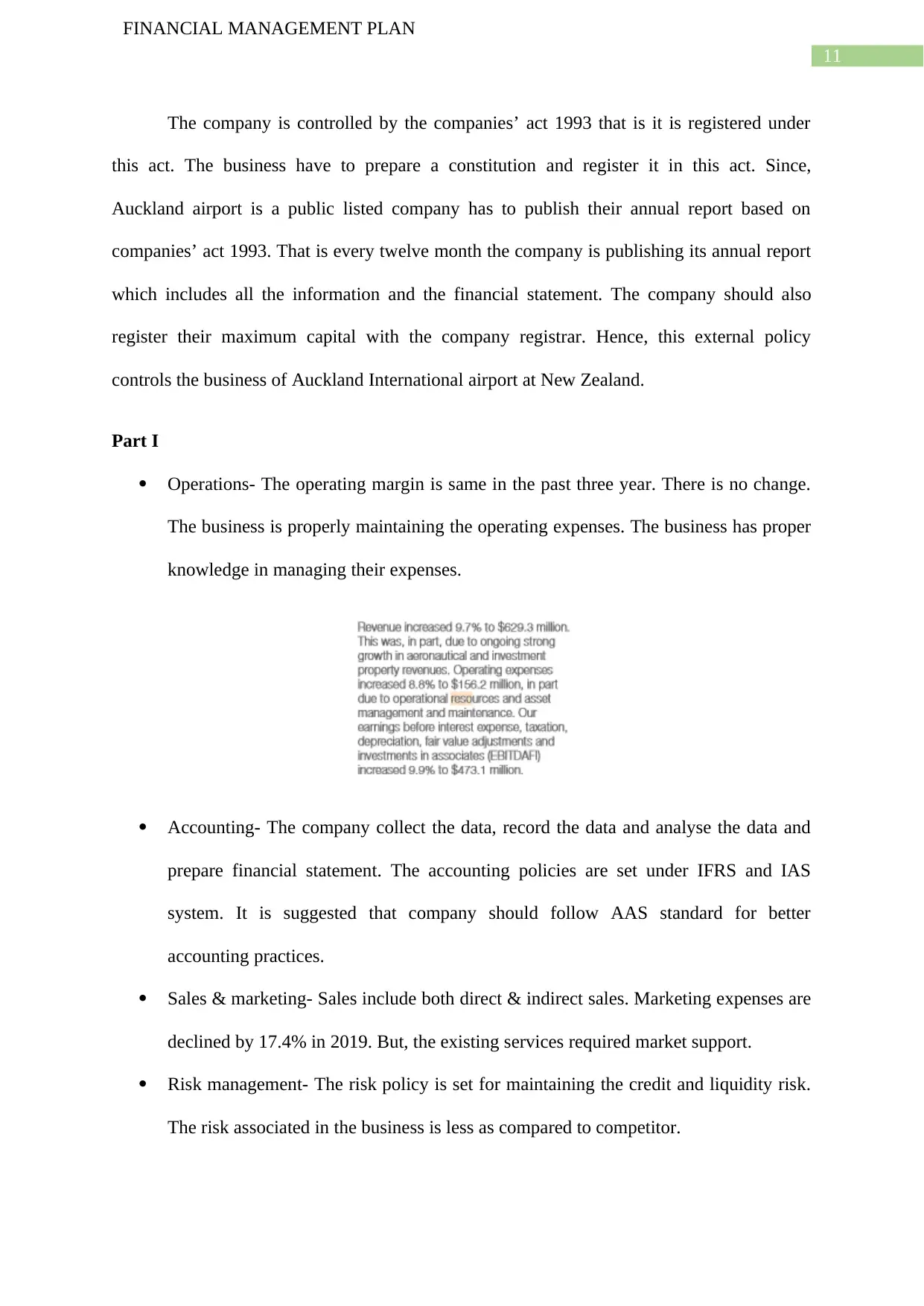
11
FINANCIAL MANAGEMENT PLAN
The company is controlled by the companies’ act 1993 that is it is registered under
this act. The business have to prepare a constitution and register it in this act. Since,
Auckland airport is a public listed company has to publish their annual report based on
companies’ act 1993. That is every twelve month the company is publishing its annual report
which includes all the information and the financial statement. The company should also
register their maximum capital with the company registrar. Hence, this external policy
controls the business of Auckland International airport at New Zealand.
Part I
Operations- The operating margin is same in the past three year. There is no change.
The business is properly maintaining the operating expenses. The business has proper
knowledge in managing their expenses.
Accounting- The company collect the data, record the data and analyse the data and
prepare financial statement. The accounting policies are set under IFRS and IAS
system. It is suggested that company should follow AAS standard for better
accounting practices.
Sales & marketing- Sales include both direct & indirect sales. Marketing expenses are
declined by 17.4% in 2019. But, the existing services required market support.
Risk management- The risk policy is set for maintaining the credit and liquidity risk.
The risk associated in the business is less as compared to competitor.
FINANCIAL MANAGEMENT PLAN
The company is controlled by the companies’ act 1993 that is it is registered under
this act. The business have to prepare a constitution and register it in this act. Since,
Auckland airport is a public listed company has to publish their annual report based on
companies’ act 1993. That is every twelve month the company is publishing its annual report
which includes all the information and the financial statement. The company should also
register their maximum capital with the company registrar. Hence, this external policy
controls the business of Auckland International airport at New Zealand.
Part I
Operations- The operating margin is same in the past three year. There is no change.
The business is properly maintaining the operating expenses. The business has proper
knowledge in managing their expenses.
Accounting- The company collect the data, record the data and analyse the data and
prepare financial statement. The accounting policies are set under IFRS and IAS
system. It is suggested that company should follow AAS standard for better
accounting practices.
Sales & marketing- Sales include both direct & indirect sales. Marketing expenses are
declined by 17.4% in 2019. But, the existing services required market support.
Risk management- The risk policy is set for maintaining the credit and liquidity risk.
The risk associated in the business is less as compared to competitor.
⊘ This is a preview!⊘
Do you want full access?
Subscribe today to unlock all pages.

Trusted by 1+ million students worldwide
1 out of 19
Related Documents
Your All-in-One AI-Powered Toolkit for Academic Success.
+13062052269
info@desklib.com
Available 24*7 on WhatsApp / Email
![[object Object]](/_next/static/media/star-bottom.7253800d.svg)
Unlock your academic potential
Copyright © 2020–2025 A2Z Services. All Rights Reserved. Developed and managed by ZUCOL.





